80 Days is a narratively-driven text adventure inspired by and expanding upon Jules Verne’s pioneering adventure novel, Around the World in 80 Days. I play as Jean Passepartout, a French former acrobat employed as a manservant for the wealthy and reserved English gentleman, Phileas Fogg. Fogg has just accepted a brash wager from his peers in London’s Reform Club that he can circumnavigate the Earth in under eighty days. As Fogg’s valet, it falls to me to maintain our inventory of clothes, tools, and other helpful items, barter valuables to fund the journey, and attend to Fogg’s genteel needs. But the most important decisions I make are where we will travel next on our globetrotting adventure around the world.
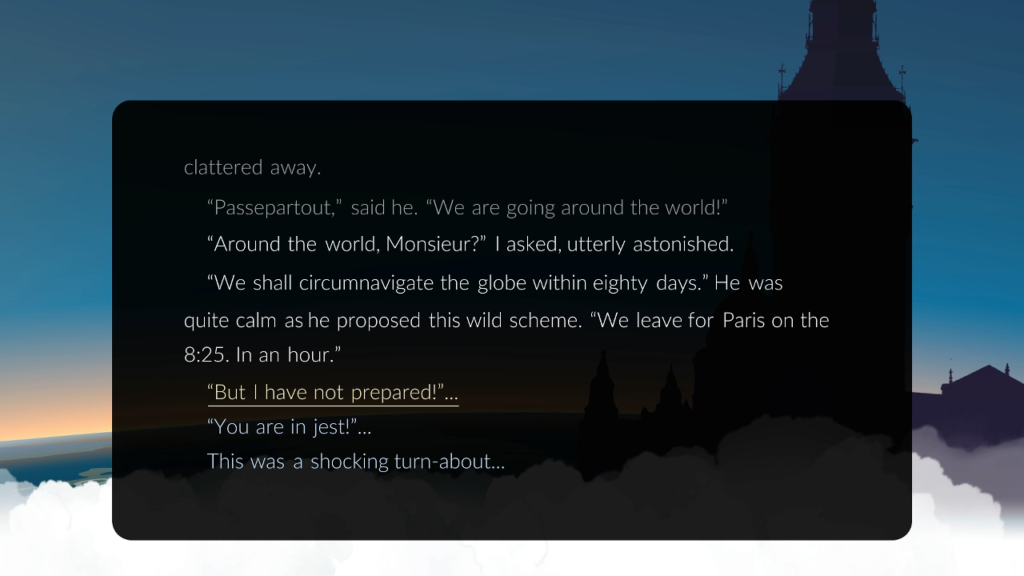
As the videogame begins, Fogg informs me of the wager and announces that a train will carry us both to Paris in a little over an hour. Giving me £4,000, he instructs me to fetch his Evening Jacket and an Altimeter from his apartment and meet him at the station before the train departs.
At Fogg’s apartment, I am thrust into the inventory management system. As the clock ticks away in condensed time to the train’s departure, I select the Evening Jacket and Pocket Altimeter and drag them into my suitcase. These items will aid us on our journey. The Evening Jacket is part of the Englishman’s Wardrobe set; the more pieces we have, the faster we will travel through places where an Englishman is recognized and respected. The Pocket Altimeter, part of the Air Traveller set, has a similar effect on aircraft. As Fogg and I travel, I must part with items which are no longer useful while picking up new ones which may aid us with future transport.
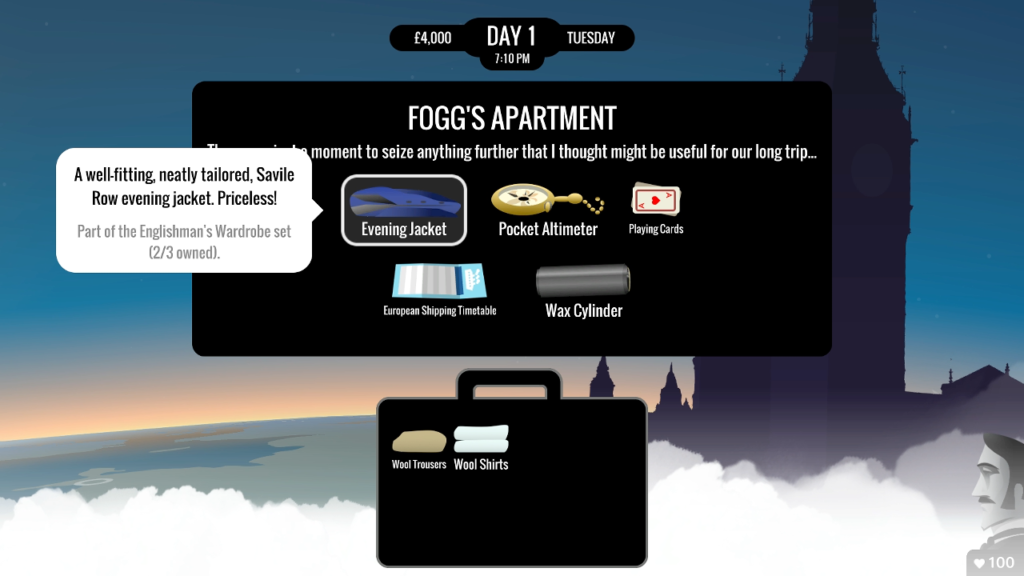
Other items still remain in Fogg’s apartment: A pack of Playing Cards and a wax recording Cylinder. The Playing Cards are a useful tool when conversing with “official and soldier types,” coaxing them into giving me more advice about our travels and the state of the world. The Wax Cylinder is much more practical: Its descriptive text informs me that I may sell it in Vienna, Paris, or Copenhagen for a significant profit. I find many of these valuables across the world, but pursuing lucrative trades may also require a less efficient route. Success requires a careful balance between travel efficiency and monetary payoffs.
My suitcase is already stuffed with Fogg’s requested items, and I will need to spend some of our limited funds on another if I want to carry more valuables. With the clock ticking ever closer to the train’s departure, I leave the rest of the items and rush to the train station. There I discover I accidentally made the right choice: Our seats only have room for one suitcase. If I had drug along a second suitcase, I would have to pay extra for more space, or leave some of our valuable items lying on the street. Making the train just in time, we depart for Paris and the first stop in our grand adventure.
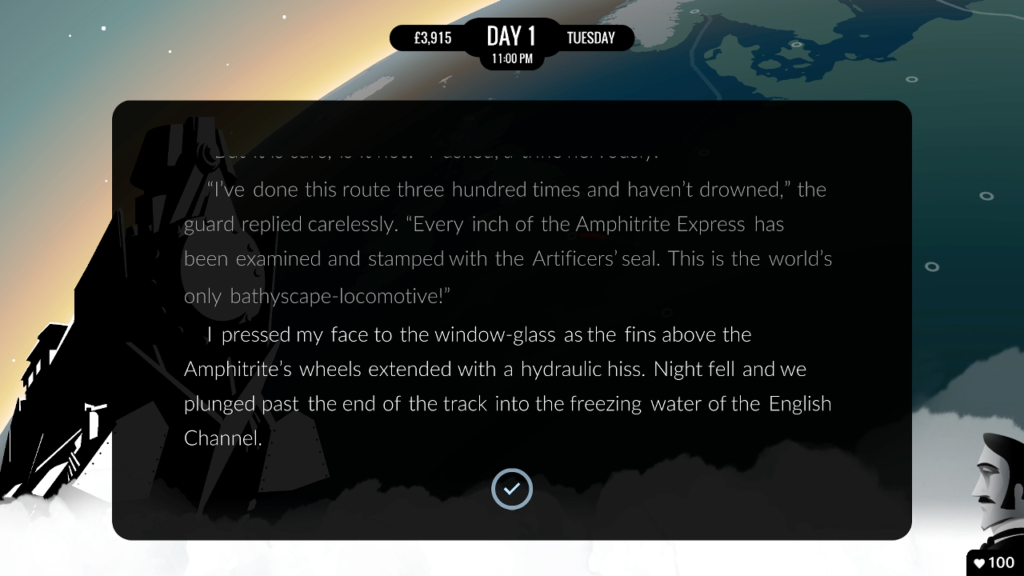
Crossing the English Channel to Paris is where I get my first clear vision of 80 Days’ world. It is not our own. The Amphitrite Underwater Express carries its passengers along the English Channel’s floor to continental Europe over one hundred years before the Channel Tunnel will be constructed in our world. When Fogg and I arrive in Paris, steam-powered automaton porters carry us and our luggage off the train. Over our adventures, we may take carriages powered by motorized horses, great cruisers that can transform into submersibles, soaring airships with opulent accommodations for wealthy clientele, and still other, more fantastic modes of travel.
Yet the world of 80 Days is impacted by the same events that affected our own. Despite the steampunk-inspired modes of travel, the most practical way to cross Europe, Asia, and the United States is by train. In Egypt, the Suez Canal has just opened, and Fogg brings it up as a possible route we may take to enter Asia. The Franco-Prussian War still happened, and my French player character laments the “scars” left on his hometown following its conclusion during a brief visit. The world is still gripped by European colonialism, which was at its height at the time of the story. This world is viewed from a contemporary perspective, recognizing the ugliness and cruelty of the time. 80 Days does not flinch away from portraying these historical facts without sacrificing a fun, breezy tone.
Following a restful stay at the Ritz, Fogg and I leave Paris for Munich on the Orient Express.
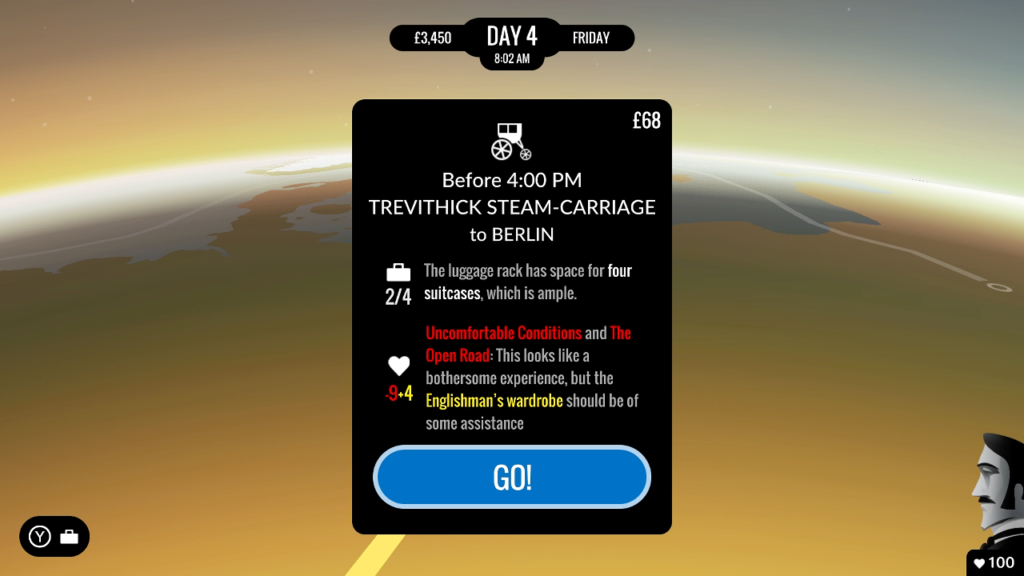
As we travel, I must keep a wary eye on Fogg’s mood. A heart meter is omnipresent in the screen’s bottom-right corner, ticking down from one hundred with every choice I make. Ignoring Fogg or behaving in ways which he disapproves will cause the meter to drop. Slow or arduous routes may also bring him down. If his mood drops too low, he may be unwilling to make the next leg of the journey until I spend a few days cheering him up.
Thankfully, Fogg is remarkably low-maintenance for an archetypical Victorian patrician. Between destinations, I can periodically check in with him to immediately restore several points to his mood meter. I can also choose to attend Fogg during our overnight stays at the world’s finest hotels, earning many more points. These check-ins are literally as simple as selecting Fogg’s icon on the screen; he gives a mild compliment to my generic skill, and his mood improves by several points. This method alone is enough to keep Fogg’s mood capped at all times. He’s so easy to please it feels like I have to deliberately try to make him unhappy.
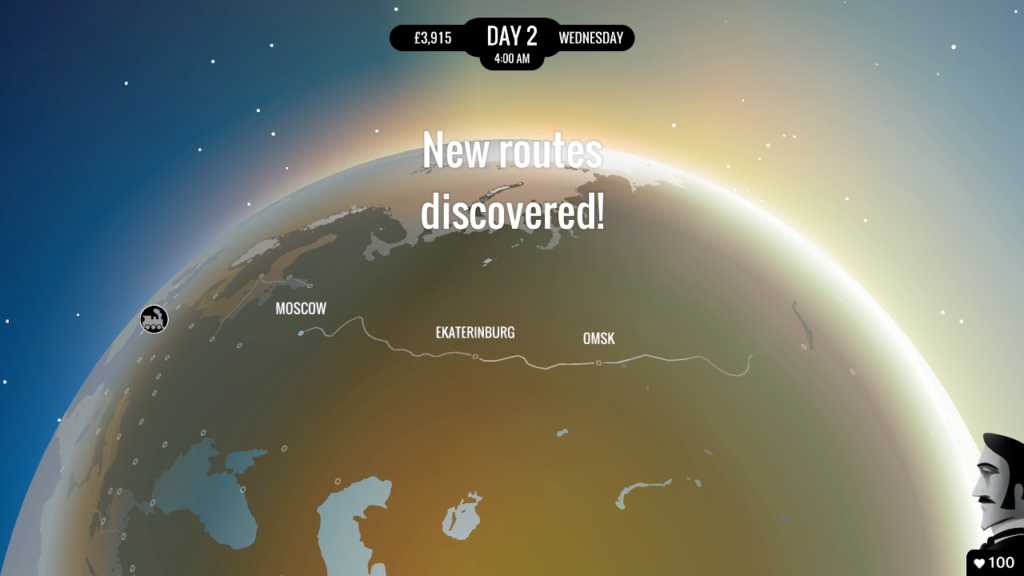
Unlike Verne’s novel, which follows a logical and straightforward route for his time, in 80 Days I am able to take unorthodox routes that crisscross the globe. Purchasing maps in each town and speaking with other travelers during transport adds routes we may consider. These add themselves to my world map as snaking lines between each city, Indiana Jones-style. Fogg and I may visit every continent but Antarctica in search of unlikely transportation that will deliver us to London before the deadline.
Each route tells a story. Some stories are small and mundane, told over two or three paragraphs. Others are much longer and filled with international intrigue, murder mysteries, swashbuckling adventures, or slapstick ensemble comedies. Some are self-contained. Others are parts of longer arcs involving recurring characters and conflicts happening adjacent to Fogg’s wager, requiring experimentation and careful planning to witness in their entirety.
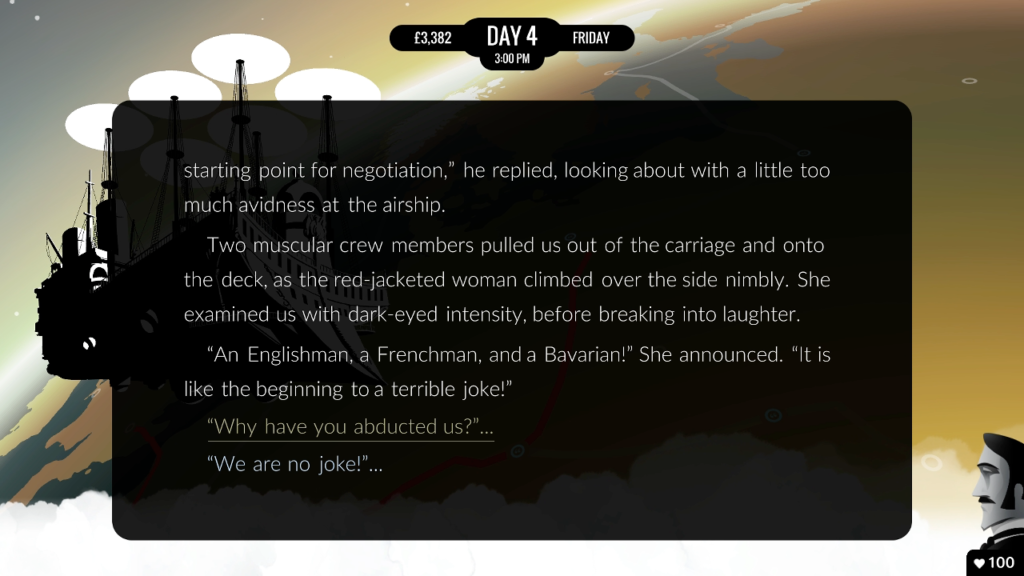
Traveling by steam-powered carriage to Berlin, Fogg and I are captured by sky pirates who hoist our vehicle into their airship using giant mechanical claws. We are in luck, however. Behiye bint Kasim, the Turkish captain of the Canavar, proves an amiable sky pirate who is only interested in our carriage’s engine to repair her ship. Learning of Fogg’s wager, she happily takes us the rest of the way to Berlin, depositing us there with all of our luggage. She also takes me aside and asks me a favor: Deliver an eye carved from lapis lazuli to the Artificer of Sülemaniye in Istanbul, and he will give us a handsome reward.
My plan was to make our way up to Russia to cross Asia on the Trans-Siberian Railroad, but with this new tip about a reward that could replenish our rapidly-diminishing funds, I change course southeast for Istanbul. We arrive there a few days later without too much trouble. Taking an afternoon to explore the city by myself, I find the Artificer’s shop and deliver Captain Kasim’s artificial eye. As promised, I receive a hefty reward.
This is where our expedition goes horribly wrong.
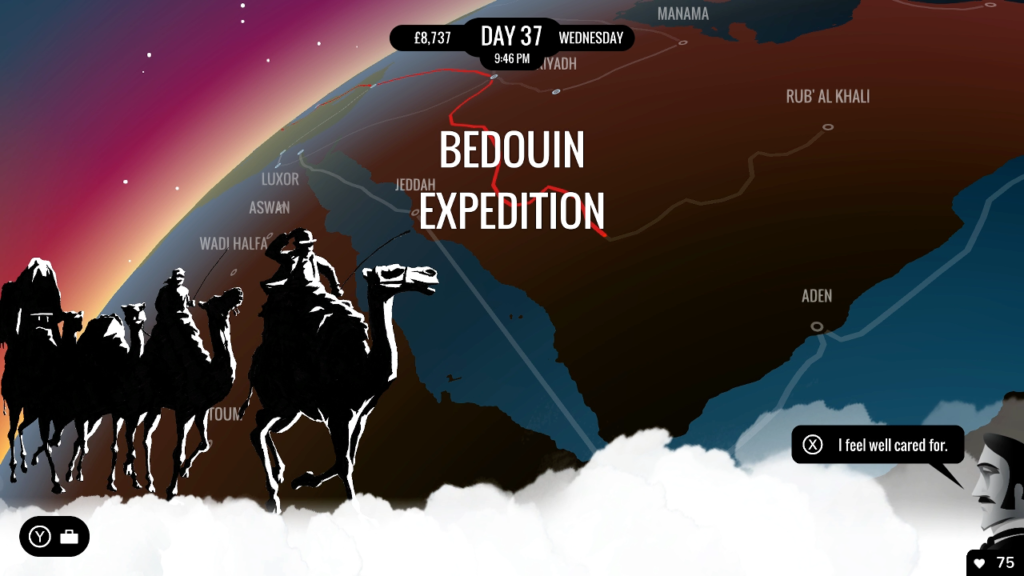
Now a long way from the Trans-Siberian Railroad, Fogg and I forge a clumsy route east, eventually arriving on Day 29 in Ha’il, a town southwest of Baghdad. Through a stroke of equal parts foolish curiosity and frugal caution, I opt to join a Bedouin Caravan, taking a weaving route across the Rub’ al-Khali desert on camelback. At six days, it’s not the most efficient route, but for £140 it’s difficult to argue with the price, and I hope to continue all the way to the Indian Ocean beyond it.
I get to know Nasser, the only Bedouin who speaks English, and I try to impress him by helping out with the caravan’s chores. I mostly fail, but Nasser is amused by my efforts. After six days, I am dismayed to find we are only halfway to our destination. Clearly, I was misled about the finer details of this journey. I also grow closer to Hafsa, Nasser’s sister.
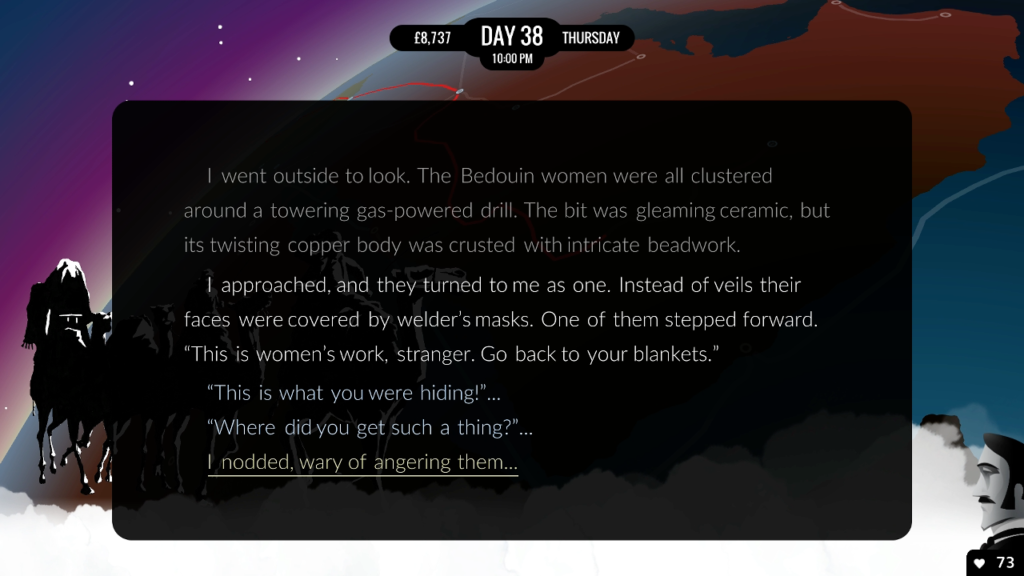
The women traveling with the caravan attend to a sled covered in a white sheet. When I inquire about it, Hafsa warns me away. “Women’s business,” she chides me. A few nights later I am awoken by the sounds of engines. Outside, I find all the Bedouin women have swapped their veils for welding masks. Using a drill carried on the covered sled, they dig into the ground and strike water, replenishing the caravan’s supplies.
Finally we arrive at our destination: A huge pyramid quite literally in the middle of the desert. Arcs of lightning course from the pyramid and up into the sky. Swallowing our fear, Fogg and I follow the Bedouin inside. I learn the pyramid is the scientific workshop of an engineering prodigy named al-Talib, who immediately suspects I am an agent sent by Thomas Edison to steal her secrets. She deals with me and Fogg by making us guinea pigs in her next teleportation experiment.
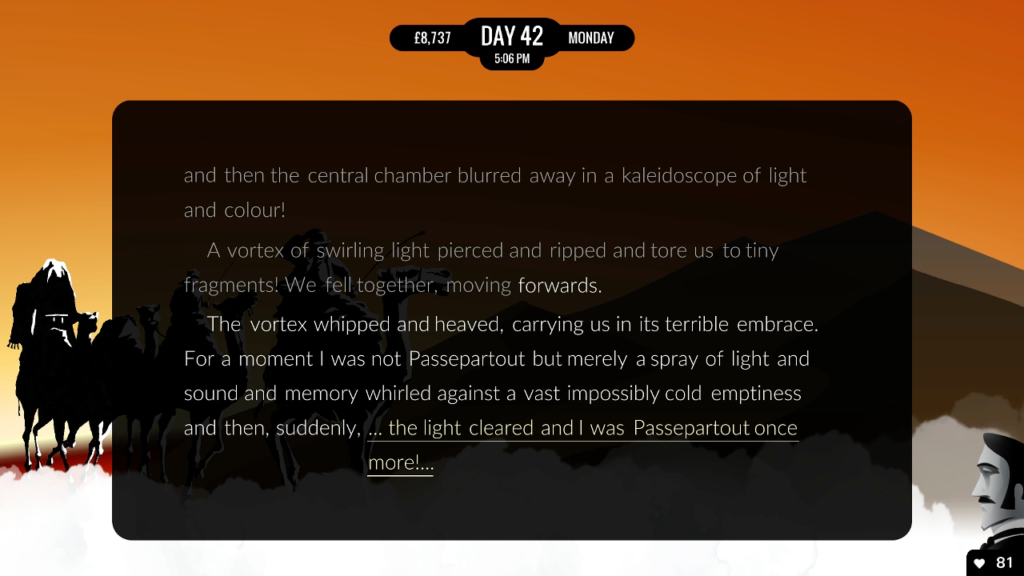
In a flash, Fogg, myself, and our luggage are transported from the Middle East to Omsk on Russia’s northern border. It is Day 42, and our six day trek across a blazing desert to save a few pounds has turned into a two week catastrophe. Half our time to the deadline has gone, and we have not even reached the Pacific Ocean. To further poison us with irony, Omsk is on the Trans-Siberian Railroad line. Resuming my original plan, we ride the train to Russia’s east coast, then to Yokohama in Japan, then board the cruise ship Waterlily heading for the United States.
On Day 66 as the Waterlily crosses the Pacific Ocean, Fogg and I reach the halfway point of our journey and with some frustration I accept we’re not going to make it back to London in time. An unexpected storm sends the Waterlily to Hawaii instead of its intended destination of San Francisco, further delaying us. From there we make our way to Central America, across the Caribbean Islands, then up the eastern coast of the United States to New York City. We arrive broke on Day 98 and have to wait a week for a bank loan to come in to afford the airship ticket back to London.
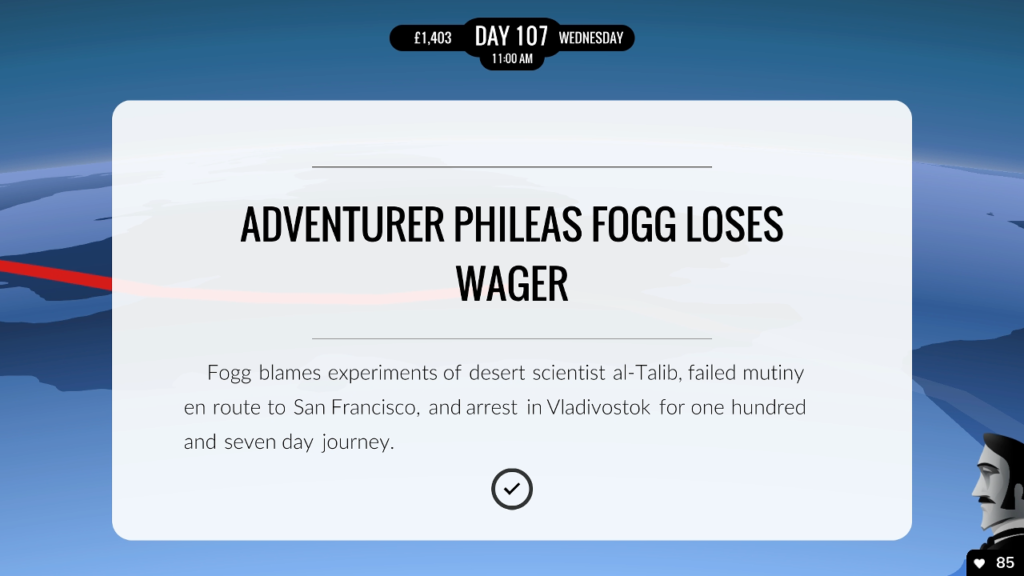
Finally, we limp back into London on Day 107, almost a full month beyond Fogg’s wager of eighty days. Fogg dutifully reports to the Reform Club to accept his loss and pay the winners, then we return to his apartment. There, he compliments me on my dedication.
Then Fogg proposes we try to finish the bet again.
There doesn’t seem to be a way to actually lose in 80 Days. Wherever I am in the world when the deadline arrives, the journey continues nevertheless, though with a few more passages about how badly we are losing. If I want to dilly-dally around, exploring every city on every continent east of London, there isn’t anything stopping me. Even running out of funds only requires an extended stay in a city waiting for a bank loan to come in.
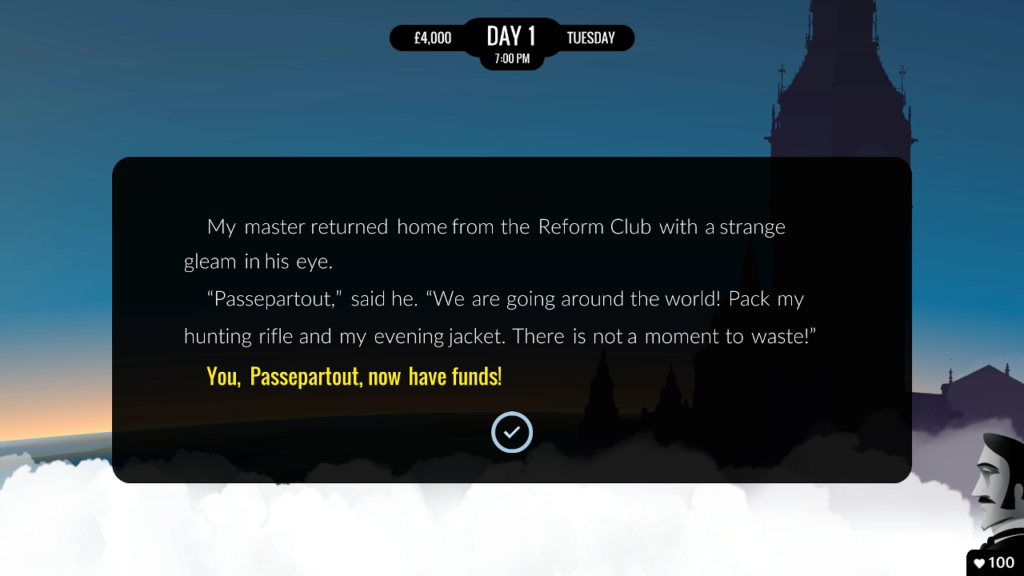
Despite this freedom to do as I please, the point of 80 Days is to finish circumnavigating the globe in under eighty days, and I am determined to do it before I consider the game beaten. I agree to a new expedition, the clock resets, and once again Fogg and I set out for Paris with a few select items taken from his apartment.
On our second attempt, I don’t waste any time tooling around Europe getting hijacked by pirates and wandering down to Istanbul. In Paris we immediately board the Orient Express to Bucharest, and from there hop across multiple rail lines to Russia’s eastern edge. Sneaking past a military blockade in Vladivostok, we reach Yokohama and board the Waterlily—the same ship we took on our first attempt. This time when we reach the halfway point of our journey, it is Day 50. Not great, but more than two weeks faster than our last attempt.
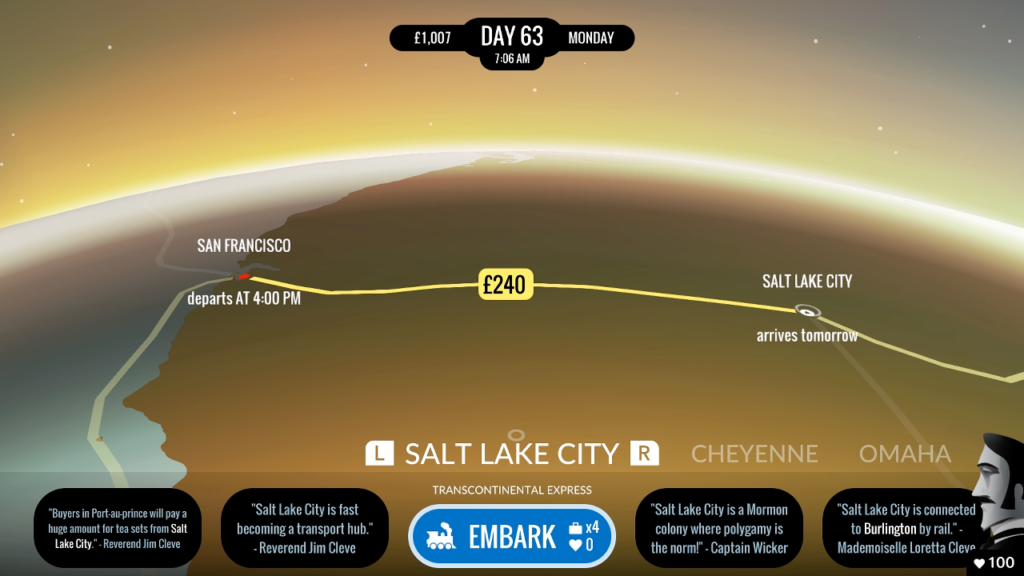
We make landfall in San Francisco on Day 63 and I know my next few choices must be decisive. The expensive Waterlily ticket has left our funds almost depleted, but I prioritize a speedy route to New York City over a cheaper one even knowing we will arrive too poor to afford the airship ticket and short on time to wait for a bank loan.
The chance pays off. On a train ride up the United States’ east coast, I make the acquaintance of a championship boxer who challenges me to a sparring match. After a brief coaching session with Fogg, I enter the ring and somehow emerge the victor. The prize money we make is just enough to buy the airship ticket from New York City to London. On the final stretch of our journey, I ignore Fogg’s suggestion that I bribe the engineer to make the ship move faster. Who knows what disaster could happen. We arrive on Day 78 and Fogg returns to the Reform Club to general astonishment and delayed celebration.
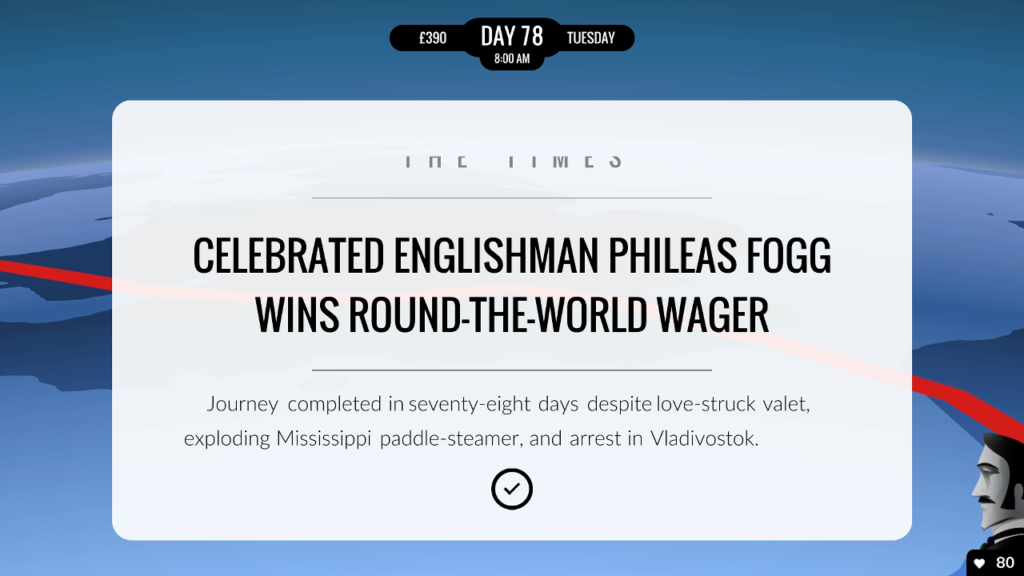
My second, more successful expedition is a much shorter, much less interesting one, but it still feels good to see Fogg around the world in eighty days. Many more routes, both successful and unsuccessful, still remain undiscovered to me. 80 Days can be beaten in a few hours, if I know what I’m doing, but to participate in every story that exists across the world will take many hours more.
80 Days is one of the most delightful videogames I have had the pleasure to write about on this website. It is neither difficult to understand nor challenging to play, and though I take some satisfaction in successfully completing Fogg’s wager, I take far more in simply visiting as many places around the world as I can just to see what happens there. The only caution I can provide is that it’s a reading-heavy experience; simple graphics represent characters, items, and landmarks, but to truly “see” the world I must interpret its expertly crafted prose. This did not prove an obstacle towards my considerable enjoyment of 80 Days. It’s a marvelous adventure videogame.